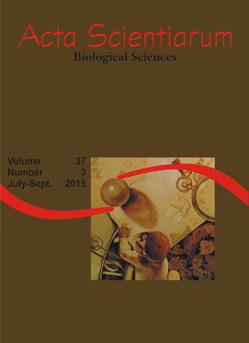<b>Rotifer community structure along a stretch under the influence of dams in the Upper Paraná River floodplain
Resumo
The construction of reservoirs imposes substantial impact on freshwater ecosystems and changes the ecological aspects of the lotic system downstream of dams. We hypothesized an increasing dissimilarity between communities in the sampling sites according to increasing distance from the Porto Primavera Dam. In addition, we expect that the rotifer community in the last sampling site will be influenced more by environmental variables related to trophic status. Samplings were conducted under the water surface of ten sites on the Paraná River in August 2013. Environmental variables were also determined. The highest number of taxa belonged to families Brachionidae, Lecanidae and Trichocercidae. The most abundant species was observed to Synchaeta oblonga, Keratella cochlearis, Brachionus calyciflorus. The species dissimilarity between sampling sites, tested using the Sorensen index, showed high dissimilarity between sampling sites. Redundancy analysis indicated a significant relationship between environmental variables (total phosphorus and ammonia) and abundance of Brachionus calyciflorus and Keratella cochlearis, in the last sampling site. Our results suggest a greater dissimilarity between the rotifer communities according to increasing distance from the Porto Primavera Dam. In addition, a higher influence of the environmental variables related to trophic conditions was observed in the last sampling site, and influenced indirectly the occurrence and abundance of some rotifer species, due to increased availability of food resources, confirming the predicted hypothesis.
Downloads
DECLARAÇÃO DE ORIGINALIDADE E DIREITOS AUTORAIS
Declaro que o presente artigo é original, não tendo sido submetido à publicação em qualquer outro periódico nacional ou internacional, quer seja em parte ou em sua totalidade.
Os direitos autorais pertencem exclusivamente aos autores. Os direitos de licenciamento utilizados pelo periódico é a licença Creative Commons Attribution 4.0 (CC BY 4.0): são permitidos o compartilhamento (cópia e distribuição do material em qualqer meio ou formato) e adaptação (remix, transformação e criação de material a partir do conteúdo assim licenciado para quaisquer fins, inclusive comerciais.
Recomenda-se a leitura desse link para maiores informações sobre o tema: fornecimento de créditos e referências de forma correta, entre outros detalhes cruciais para uso adequado do material licenciado.












1.png)




3.png)













